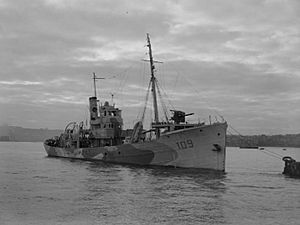HMT Lord Hailsham facts for kids
 |
|
Quick facts for kids History |
|
|---|---|
| Name | HMT Lord Hailsham |
| Namesake | Douglas Hogg, 1st Viscount Hailsham |
| Builder | Cochrane & Sons Shipbuilders Ltd, Selby |
| Launched | 30 June 1934 |
| Completed | August 1934 |
| Acquired | August 1939 |
| Commissioned | October 1939 |
| Fate | Sunk on 27 February 1943 |
| General characteristics | |
| Type | Armed trawler |
| Displacement | 445 tons |
| Length | 156 feet (48 m) |
| Sensors and processing systems |
ASDIC |
| Armament |
|
HMT Lord Hailsham (FY109) was a ship used by the Royal Navy during the Second World War. It was originally a fishing boat called a trawler. The ship was named after a famous person named Douglas Hogg, 1st Viscount Hailsham.
What was the Lord Hailsham?
The Lord Hailsham was a special kind of ship. It started as a fishing trawler but was changed to help fight against enemy submarines. This was called "anti-submarine warfare."
The ship had a big gun on the front, about 4 inches (102 mm) wide. It also had two smaller machine guns on the sides of the bridge. These guns could shoot at enemy planes or other ships.
To find submarines underwater, the ship used a special sound system called ASDIC. It also carried up to 14 depth charges. These were like big bombs that could explode underwater to destroy submarines. Later, the ship also got a Holman Projector, which could launch bombs.
In 1942, the ship received a special crest, which is like a family symbol, from the Hailsham family. This crest was placed on the front of the ship's bridge.
The Lord Hailsham sailed in important areas like the English Channel and the Eastern Atlantic Ocean.
How did the Lord Hailsham sink?
On 27 February 1943, the Lord Hailsham was sailing with a group of ships, protecting them. This is called "convoy duty." They were in Lyme Bay when German E-boats attacked them. E-boats were fast, small attack boats.
The Lord Hailsham was one of five armed ships protecting a group of eight merchant ships. These merchant ships were carrying goods from South Wales to Southampton.
Sadly, the Lord Hailsham was sunk during this attack. Four of the merchant ships in the convoy were also lost.
One of the crew members, Seaman James Robert Beatty, was honored for his quick actions. He helped save lives when the ship was hit.

